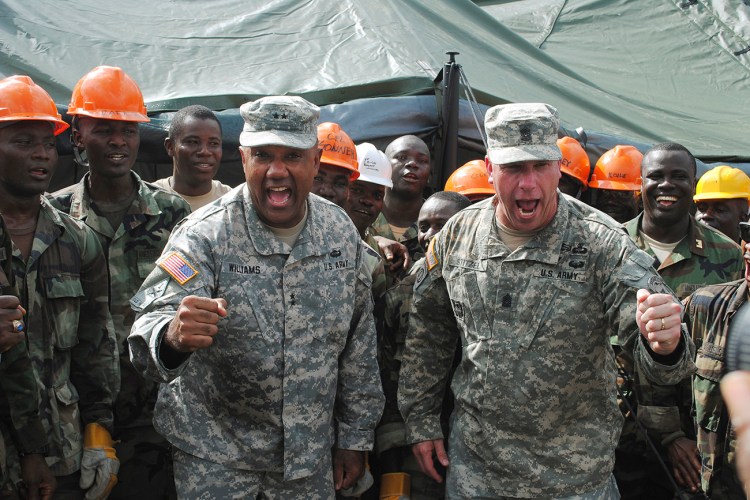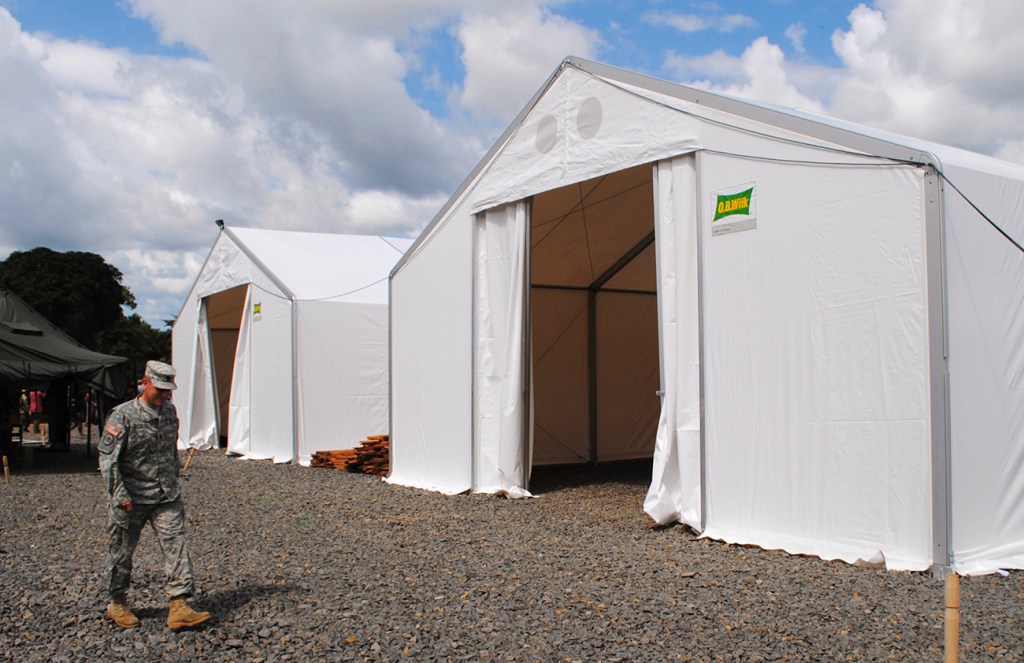TUBMANBURG, Liberia — Near the hillside shelter where dozens of men and women died of Ebola, a row of green U.S. military tents sit atop a vast expanse of imported gravel. The generators hum; chlorinated water churns in brand-new containers; surveillance cameras send a live feed to a large-screen television.
There’s only one thing missing from this state-of-the-art Ebola treatment center: Ebola patients.
The U.S. military sent about 3,000 troops to West Africa to build centers like this one in recent months. They were intended as a crucial safeguard against an epidemic that flared in unpredictable, deadly waves. But as the outbreak fades in Liberia, it has become clear that the disease had already drastically subsided before the first American centers were completed. Several of the U.S.-built units haven’t seen a single patient infected with Ebola.
It now appears that the alarming epidemiological predictions that in large part prompted the U.S. aid effort here were far too bleak. Although future flare-ups of the disease are possible, the near-empty Ebola centers tell the story of an aggressive American military and civilian response that occurred too late to help the bulk of the more than 8,300 Liberians who became infected. Last week, even as international aid organizations built yet more Ebola centers, there was an average of less than one new case reported in Liberia per day.
“If they had been built when we needed them, it wouldn’t have been too much,” said Moses Massaquoi, the Liberian government’s chairman for Ebola case management. “But they were too late.”
It was impossible to predict the decline in the Ebola caseload last September, when the U.S. Centers for Disease Control and Prevention suggested a worst-case scenario of 1.4 million victims in Liberia and Sierra Leone. At that point, the American military’s logistical and engineering prowess appeared to be urgently needed — even if critics said the assistance was slow to arrive.
“With that kind of dire prediction from the CDC, and not having seen anything like this before, we had to try everything at our disposal,” said Douglas Mercado, the top USAID official in Liberia.
U.S. officials reject the suggestion that resources were misallocated.
“A lot of people are evaluating the strategy based on what we know today, not what we knew at the time,” said Maj. Gen. Gary Volesky, the top U.S. military officer in Liberia.
Before the center opened in Tubmanburg on Nov. 18, there were about 200 suspected or confirmed Ebola victims in the town, many of whom died while awaiting treatment. Since the U.S. facility opened, 46 suspected or confirmed cases have been admitted.
In Monrovia, 45 miles away and the heart of the outbreak, the scenes of suffering Ebola patients shocked the world. At the height of the epidemic, the afflicted writhed in the streets. There was a shortage of bed space at treatment centers for months. The international community, led by the United States, responded with a massive construction and assistance campaign — including American engineers, Cuban doctors, African Union health workers and many others — that turned out to be far in excess of what was necessary.
There are now seven Ebola treatment centers in greater Monrovia. Most of them were completed after the epidemic began to abate. Surplus tents now store excess supplies: mattresses, food and medicine for patients who never arrived. There are so few patients and so many available beds that a USAID-funded Ebola center, opened in October, will soon close its doors. Three other centers will be shuttered at least temporarily.
Paradoxically, isolation centers are still being built, mostly by UNICEF.
“It just makes no sense,” said Laurence Sailly, the head of mission for the Doctors Without Borders aid group in Liberia.
Amelia Garbla remembers when she saw the first American aircraft land in Tubmanburg. It was late September, and she was a nurse at the local holding center — little more than plastic sheeting and dirty mattresses — where Ebola patients were dying constantly.
“I was jumping up and down and waving. I was so happy,” she said.
About two weeks earlier, on Sept. 16, President Barack Obama announced that 3,000 U.S. troops would be dispatched to West Africa as part of a $758 million plan to fight Ebola.
“We know that if we take the proper steps, we can save lives,” Obama said. “But we have to act fast.”
The news of Obama’s plan had made it to Garbla’s makeshift treatment center, with its tiny shed for nurses to don their protective gear. The situation was desperate.
“There was nothing we could do. The things we should have had, we didn’t have,” she said.
Through September and October, Garbla was surrounded by the dead and the dying, including 14 of her colleagues — health-care workers from this small city who fought the disease with almost no outside help. She saw the American helicopters and the white men in uniform surveying the land. She watched as they unloaded equipment and construction materials.
“We were praying for something to be built,” she said.
But while the Americans were finishing the Tubmanburg Ebola center, their first in Liberia, the national caseload suddenly began to decline. By the time the treatment unit opened in November, the country was down to fewer than 100 cases per week, from a peak of more than 300. By December, the number had dropped to fewer than 30 cases per week.
The reasons for the sudden plunge are still being debated. Was it that Liberians had changed their behavior to avoid contracting the disease? Had early increases in bed space at Ebola centers been enough to isolate those with the virus? Was there more effective use of contact tracers, who tracked down and isolated people exposed to the virus? Experts say it was probably all of those changes, though the inflection point of the epidemic will be studied for years by epidemiologists.
“I don’t think you can point to one silver bullet that solved Ebola,” Volesky said. “My argument is it’s the whole strategy that’s showing us a positive trend.”
On a scorching day in late October, the U.S. ambassador came to tour the nearly completed Tubmanburg center. Members of the Liberian army, who helped with construction, chanted as the dignitaries walked through the new tents.
When the center began accepting patients on Nov. 20, Garbla and her colleagues were glad to have a modern, functional Ebola treatment unit, even if it appeared that the epidemic was fading. Now, if the cases spiked again, she and her colleagues would be ready.
The U.S. plans for the Ebola centers have changed in some ways to reflect the new reality. In a number of cases, aid groups contracted to operate the centers have diverted their staff members to work in general hospitals that were ravaged by Ebola. Some training sessions intended for nurses and hygienists at the Ebola centers have been altered to cover a broader range of infection-control measures.
As the disease continued to fade, U.S. officials had to decide whether to scrap their plans to build a total of 17 Ebola centers. In the end, they cut only two of the units. Their judgment appeared to be validated in December, when an isolated outbreak emerged in the county of Grand Cape Mount — where, luckily, a U.S.-built Ebola center had just been completed.
“Even when it started going down, no one was declaring victory and saying we beat this thing,” Volesky said. “Because it only takes one person walking from Guinea into Lofa,” a county in Liberia.
‘Still, there’s no question that the need is less than anticipated. For its part, UNICEF has continued building Ebola isolation centers, even though many here argue that they serve no purpose anymore.
“Halting construction now would cause much bigger problems for the community. They’ve agreed to them, they’ve supported them, and they’re employed there,” said Sheldon Yett, UNICEF’s country director.
Another U.N.-led effort, to distribute thousands of home health-care kits, has ground to a halt, with most of the supplies sitting in unopened boxes across the country.
For some of the Liberian doctors who have been fighting the disease almost since the beginning of the outbreak last spring, the continued push to construct Ebola centers makes little sense.
Jerry Brown, a doctor who directs an Ebola center just outside Monrovia, used to attend the daily meetings where international aid groups, governments and U.N. agencies would discuss the collective response to the outbreak. He watched as the epidemic faded, but the construction effort continued.
“They said: ‘We have to build it. That’s what is written, and that is what we’ll do,’ ” he said.
Out of frustration, Brown stopped attending the meetings in November.
Another Liberian doctor, J. Soka Moses, worked at one of Monrovia’s most chaotic Ebola centers, JFK Hospital, during the worst days of the crisis. It was closed in October after some health-care workers contracted the disease. Moses was eventually reassigned to a large new Ebola center built by the World Food Program and USAID.
“We are more prepared now that the outbreak is over,” he sighed. His new Ebola center, with a capacity of more than 200 beds, is now due to close.
Copy the Story LinkSend questions/comments to the editors.




Success. Please wait for the page to reload. If the page does not reload within 5 seconds, please refresh the page.
Enter your email and password to access comments.
Hi, to comment on stories you must . This profile is in addition to your subscription and website login.
Already have a commenting profile? .
Invalid username/password.
Please check your email to confirm and complete your registration.
Only subscribers are eligible to post comments. Please subscribe or login first for digital access. Here’s why.
Use the form below to reset your password. When you've submitted your account email, we will send an email with a reset code.